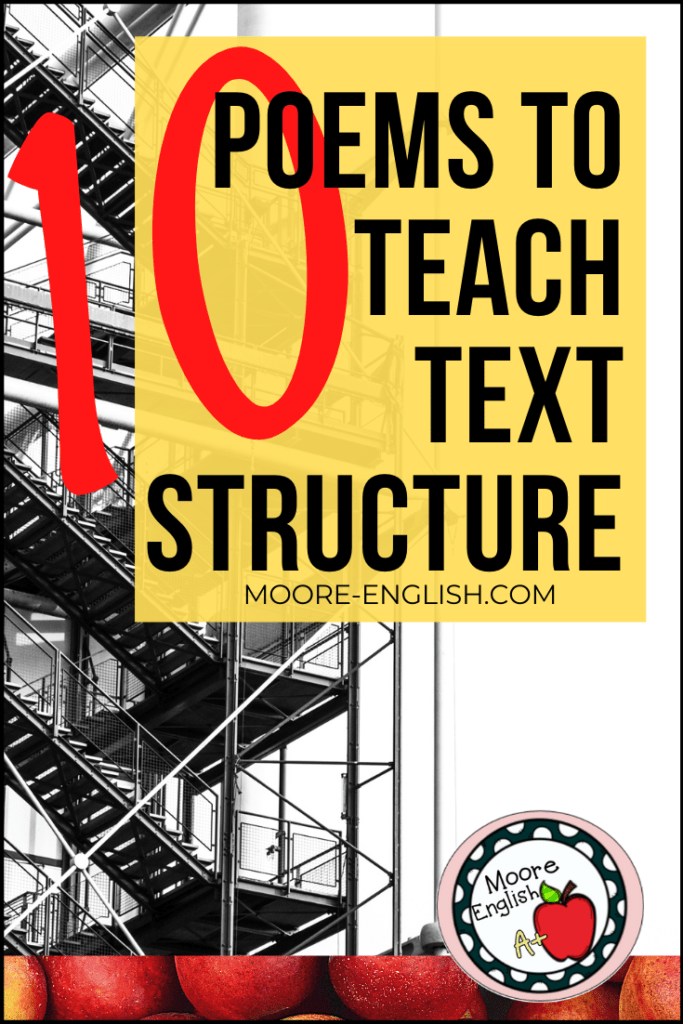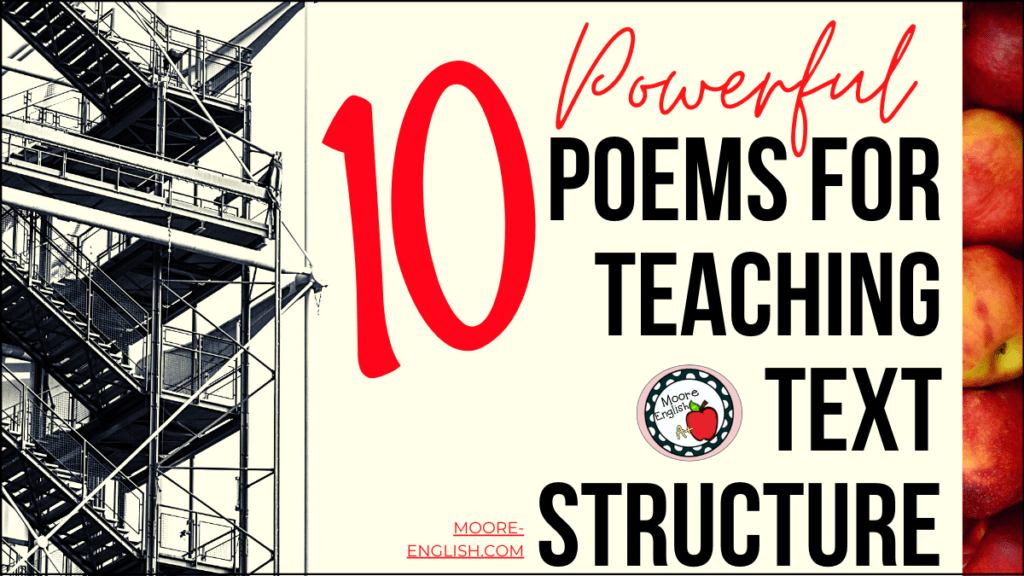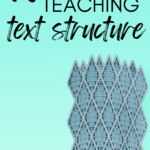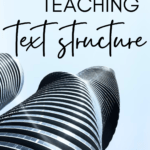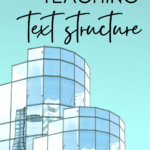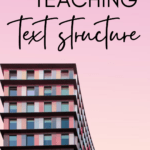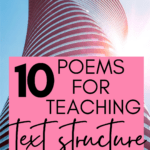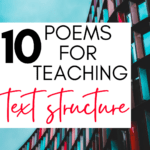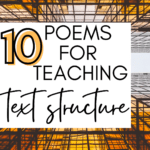A few weeks ago, my sophomores took our beginning of the year pre-test, which provides data about students’ baseline competencies. The standards assessed are the ones that feature most prominently in our curriculum and in on our state assessment.
After distance learning (re: a five-month spring break), I was curious to see where students are right now. Overall, my students did far better than I expected. However, there is always room for improvement. Based on this data, one area we will focus on is text structure.
Although I’ve made different instructional pushes over the years, focusing on goal setting, metacognition, and teaching text features, I’ve never done a text structures push.
With this in mind, I’ve put together a 10 poems that have meaningful structures. Keep reading to check them out!
This post this post may contain affiliate links. Please read the Terms of Use.
Selecting Titles for Teaching Text Structure
Finding pieces for teaching text structures can be challenging because you have to balance student engagement with selecting pieces that make meaningful choices about text structure. Overall, as I was selecting titles, here’s what I looked for:
- Firstly, I looked for titles that could be read within one class period. While we may spend several days with each text, I wanted the initial reading to take no more than one class.
- Secondly, I looked for poems that would engage students with their relevance.
- Additionally, each piece needed to make meaningful choices about text structure. For this reason, I left out a lot of contemporary poets and poems that have non-traditional structures but that don’t follow typical “rules” for structural shifts.
- Finally, for my sophomores, I chose texts that made more obvious decisions. For my juniors, I looked to pieces that have more experimental styles, more challenging context, and/or that lend themselves to literary criticism.
9-10 Titles for Teaching Text Structure
My sophomores are very sweet. But as we pre-read and annotated our first poem earlier this week, it was clear the switch to distance learning had caused them to miss out on spending time with poetry outside of The Odyssey and Romeo and Juliet. While both of those titles are fun and useful in their own ways, neither one requires the kind of close reading that a shorter poem does. With all of that in mind, here are the titles I’m going with for working on text structure:
–“Social Distancing” by Juan Felipe Herrera with design by Anthony Cody is the text I’m going to use to begin the conversation about text structure. I have a feeling this piece will instantly get my students’ attention! Not only is the subject matter relevant, the “solar circle” form of the poem is also visually engaging. In addition, this is a great poem to teach inference, point of view, author’s craft, using context clues, and analyzing syntax and diction. Read it here.
–“Easter Wings” by George Herbert is kind of like the original concrete poem. Of the poems in the 9-10 section, this is the one I’m most skeptical of because its language is dense. However, seeing the text beside Herbert’s original manuscript is powerful and really cements the text’s status as a concrete poem. Plus, this is a great poem to teach paradox, context clues, author’s purpose, setting, tone and allusion. Read it here and see the manuscript here.
–“’Hope’ is the thing with feathers -” by Emily Dickinson is a staple in many American literature classrooms. Dickinson’s unique style makes her texts ideal for teaching text structure. Furthermore, this poem lends itself to analysis of meter, syntax, rhyme, and historical context. This is a great poem to pair with my Emily Dickinson Crash Course literature listening guide and with “I heard a Fly buzz–when I died-“ (one of my favorite poems for teaching inference). Get all three Dickinson resources bundled together! Read the poem here.
–“Before a Painting” by James Weldon Johnson: As an Italian or Petrarchan sonnet, this text lends itself beautifully to analyzing text structure. I’ve only included one “true” sonnet on my list. In the past, I think I’ve relied too heavily on sonnets as a way of teaching text structures. (As though Petrarch and Shakespeare were the only people to make interesting structural choices.) Additionally, this poem lends itself to teaching mood, rhyme scheme, literary devices, context clues, setting, inference, main idea, and point of view. Read it here.
–“[i carry your heart with me (i carry it in]” by E.E. Cummings may be the best-known work on this list. Ultimately, my hope is to use this as the culmination of our study of structure because Cummings always makes structure part of the conversation in his poems! In addition, this is a great poem to teach historical context, word choice, character development, tone, and using context clues. Read it here.
All five of these poems are featured in my 9-10 Text Structure Poetry Bundle! All together, it includes 30+ pages and 90+ questions. Each poem features 3 activities, and I’ve built in lots of opportunities for students to try writing their own poems and making their own meaningful choices about text structure. Check it out here.
11-12 Titles for Teaching Text Structure
Many of my juniors have had me in language arts before, so they are familiar with the four steps for pre-reading poetry. This means they are ready to dive into more complex text structures! Here are the titles I’m planning to use with them this year:
–“Deer Dance Exhibition” by Ofelia Zepeda is unlike any poem I’ve read before. The Q & A structure of the poem makes it an ideal piece for analyzing text structure. Further, it raises significant questions about culture (how we engage with culture, exotify cultures that are not our own, and how culture can be a performance or performative). This is also a good text for teaching tone, character development, allusion, inference, and cultural context. Check it out here.
–“God’s Grandeur” by Gerard Manley Hopkins comes from my favorite poet, and this is one of his best known and celebrated works. This is the only sonnet I’m going to use with my juniors, but Hopkins’ gift for coining words and employing sprung rhythm certainly elevates the form! Plus, this is also a good text for analyzing figurative language and practicing inference. Read it here.
–“If-” by Rudyard Kipling is a classic for its optimistic views of growing up. It remains a graduation season favorite for a reason. For these reasons, it’s a great poem to use for teaching text structure. In addition, this is a great poem to teach literary devices, context clues, tone, juxtaposition, and paraphrasing. However, Kipling’s personal views complicate reading his work and necessitate reading his work through a critical lens. Read it here.
–“One Art” by Elizabeth Bishop is a poem I’d never read until I started looking for poems to use to teach text structure. This is such a powerful title! The villanelle should make a great addition to our study of text structure. In addition to helping students analyze text structure, this poem also provides opportunities for students to practice inference and analyzing point of view. Read it here.
–“One-Word Poem” by David R. Slavitt truly has one word, but it’s what happens after the poem that makes this text truly special. Of the texts included, this one may be the most challenging. However, the questions provided in the poem (or after the poem depending on your interpretation), encourage students to engage with different schools of critical theory. Read it here.
All five of these poems are featured in my 11-12 Text Structure Poetry Bundle! All together, it includes 35+ pages and 120+ questions. Each poem features 3 activities, and I’ve tried to provide variety for how students interact with texts. I can’t wait to use these with my students! Check it out here.
Last Thoughts
Even with all the world in a precarious position, I can’t help but get excited about trying out new titles in my class. I’m sure I won’t use all 10 poems with all of my students, but I’m excited to see which pieces lend themselves to whole group modeling, to small group intervention, and to assessment.
You can find all 10 poems in my 9-12 Text Structure Bundle. If you were to purchase each poetry resource individually, you’d spend $30. But with the bundle, you save $10, which is like getting 3 resources for free. Check it out today!

